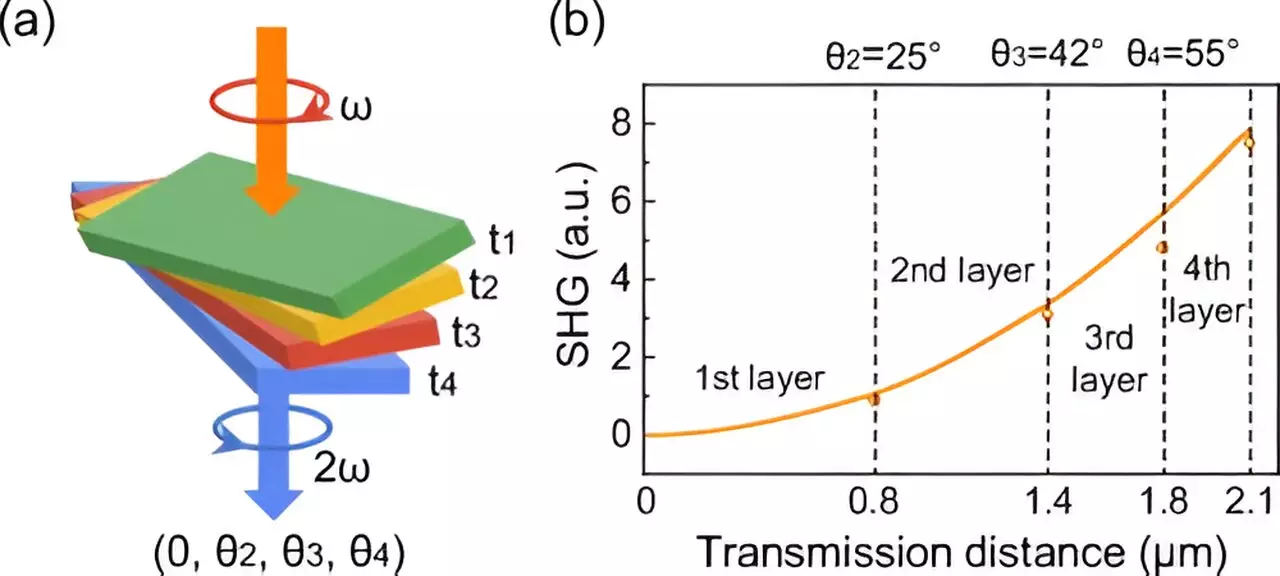Over the years, laser technology has become an integral part of the information society, offering a wide range of applications. Optical crystals play a crucial role in the functionality of laser devices by enabling frequency conversion, parametric amplification, and signal modulation. However, the existing optical crystals have faced limitations in meeting the future demands of laser technology, such as miniaturization, high integration, and functionalization. In a groundbreaking development, a team of Chinese researchers has created an ultrathin optical crystal that exhibits unprecedented energy efficiency, opening doors to next-generation laser technology.
Led by Prof. Wang Enge and Prof. Liu Kaihui from Peking University, the team introduced the Twist Boron Nitride (TBN), an optical crystal with a micron-level thickness, making it the thinnest optical crystal known to date. Compared to traditional crystals of similar thickness, the TBN crystal demonstrates energy efficiency improvements ranging from 100 to 10,000 times. This remarkable achievement signifies China’s original innovation in the theory of optical crystals and establishes a new realm of utilizing two-dimensional thin-film materials of light elements in optical crystal fabrication.
Historically, the research and development of optical crystals have largely relied on two phase-matching theories proposed by scientists in the United States. However, due to the constraints imposed by traditional theory models and material systems, existing crystals have struggled to meet the evolving requirements of laser technology. Therefore, the advancement of next-generation laser technology necessitates breakthroughs in optical crystal theory and materials.
The team of Chinese researchers has successfully developed the twist-phase-matching theory, which serves as the third phase-matching theory based on light-element material systems. This theory enables a highly coordinated direction and pace for the laser, enhancing the energy conversion efficiency. Prof. Liu explains that the laser generated by optical crystals can be visualized as a marching column of individuals, and the twist mechanism harmonizes their movements, leading to a substantial improvement in energy efficiency. This breakthrough not only presents a revolutionary design model and material system but also demonstrates original innovation encompassing the entire chain from basic optics theory to material science and technology.
The TBN crystal exhibits unprecedented characteristics that hold great potential for laser technology. With a thickness ranging from 1 to 10 microns, the TBN crystal surpasses the previous limitations of optical crystals, which were typically at the millimeter or even centimeter level. This ultrathin size opens doors for enhanced integration potential and new functionality.
The TBN production technology is currently undergoing patent applications in the United States, Britain, Japan, and other countries. In addition, the research team has already developed a TBN laser prototype and is collaborating with enterprises to further advance the development of next-generation laser technology. Prof. Wang emphasizes that optical crystals serve as the cornerstone for the progress of laser technology, and the future of this field relies on the design theory and production technology of optical crystals.
The Future Applications of TBN
Looking ahead, the TBN crystal holds immense promise for various fields, including quantum light sources, photonic chips, and artificial intelligence. The ultrathin size, exceptional integration potential, and new functionalities of the TBN crystal are expected to confront new frontiers and overcome existing limitations. Its potential application breakthroughs will pave the way for advancements in these fields, driving innovation and progress in the realms of quantum technology, data processing, and intelligent systems.
The Chinese research team’s pioneering creation of the ultrathin TBN optical crystal represents a significant milestone in laser technology. Through their novel twist-phase-matching theory and utilization of two-dimensional thin-film materials of light elements, they have shattered the limitations of traditional optical crystals. The advent of the TBN crystal brings us closer to realizing the future of laser technology, characterized by miniaturization, high integration, and functionalization. With its remarkable energy efficiency and vast potential for diverse applications, the TBN crystal is poised to transform the landscape of laser technology and propel us into a new era of innovation.


Leave a Reply